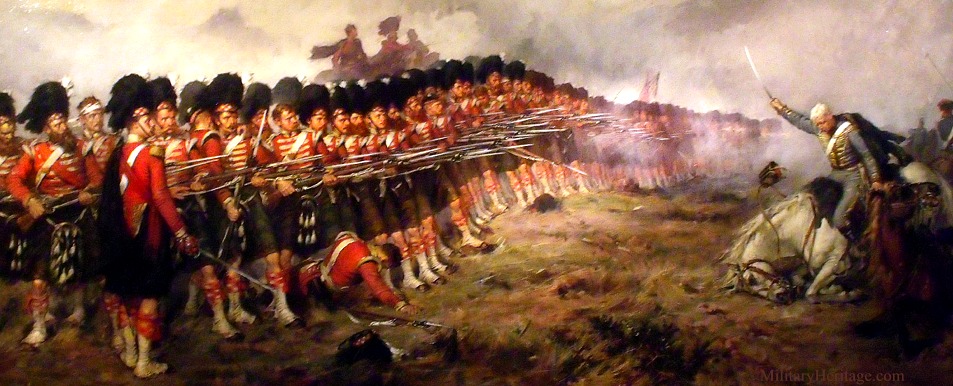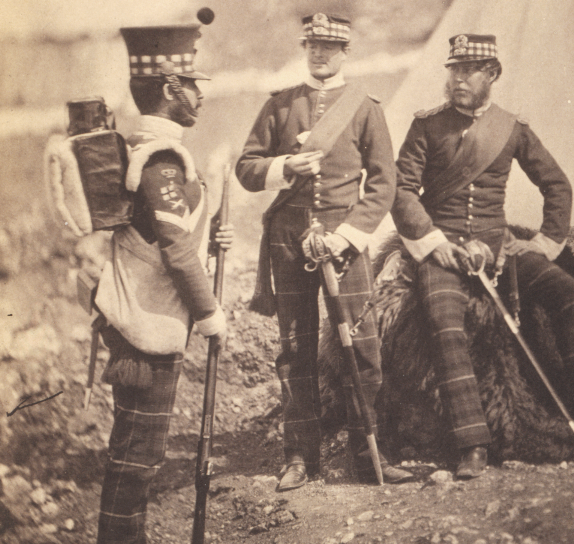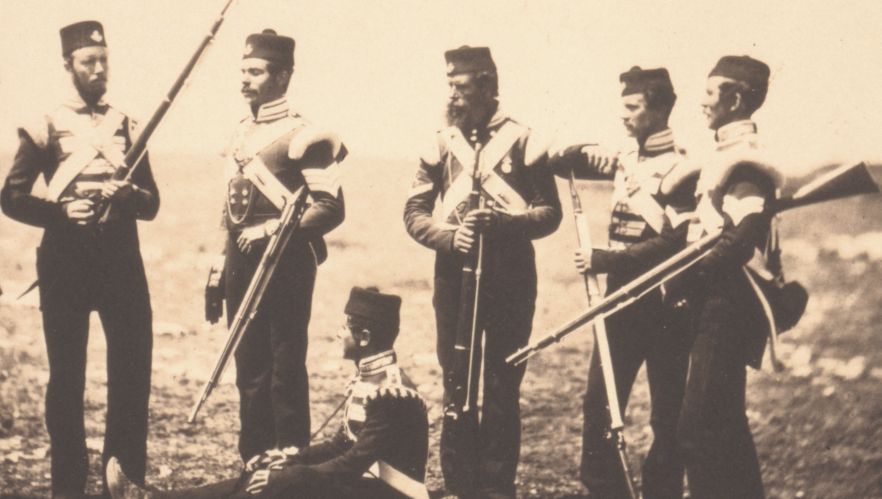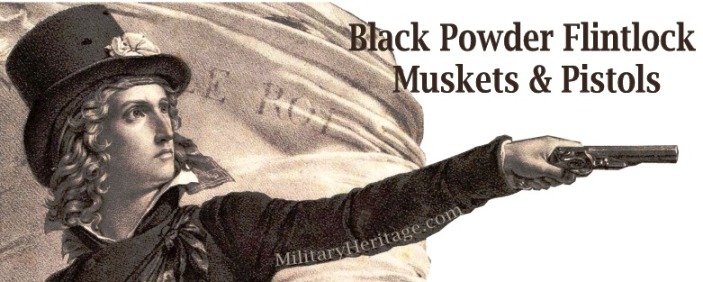On the Thin Red Line:
Loading and Firing British Muskets
during the Crimean War, 1854-1856

With
war breaking out in 1853 between the Russians and the Turks, Britain
realized it was only a matter of time before they would be drawn into
the conflict.
The British Army was in the midst of a
significant weapons transformation from smoothbore muskets to rifled
muskets.
While a number of regiments had been supplied with the
pattern 1851 Minie Rifled musket, the majority of the army still carried
the 1839 or the Pattern 1842
smooth bore musket
(1850s productions of 1842 pattern had rifled barrels added).
By the end of 1853, the
Enfield Rifled musket as approved by the War Department for the army and
was put into production.
In 1854 the political situation
deteriorated and on March 27th Britain, along with France, declared war
on Russia.

Colour Sergeant of the 71st Highland Infantry
with the Pattern 1851 Minie Rifle (Photo: Roger Fenton, 1854)
Now
on a war footing, Britain increased production of the new Enfield rifled
musket
and began to assemble 25,000 troops for the attack of Russia's key
fortress and naval base on the Black Sea: Sebastopol (located in the
Crimea).
Suffering from a chronic shortage of rifled muskets,
regiments not going to the Crimea were stripped of their Minie Rifles
which were given to the troops going.
By the time the British
force left in September they were armed with a mixture of the three
different muskets.
In an attempt to standardize the handling
of various arms in the Army a revised Platoon (loading and firing)
exercise was issued in the previous June.
By the time the
Regiments embarked they would have been well versed in the new loading
and firing drill.
This new drill was published in The Infantry
Manual containing Directions for the Drill and Instruction of Recruits,
the Manual Exercise, the Revised Platoon Exercise, an Abstract of the
Field Exercises and Evolutions of the Army &c. &c. &c.
(Whitehall, 1854).
This
is the drill used throughout the Crimean War including when the 93rd
Highlanders stood their ground in line against the onslaught of Russian
cavalry at the Battle of Balaclava.
Born from that brave act was
the phase "the thin red line" (originally the "thin red
streak" coined by The Times journalist William Howard
Russell).
As they were manufactured, pattern 1853 Enfeild Muskets were
shipped to replace the 1842 Percussion cap Brown Besses.
The
Enfield went through a couple of minor changes in 1855 including a new
ramrod and solid barrel bands. By the end of the Crimean War in 1856,
the 1842 smoothbore would have been completely replaced by a rifled
musket.
The following year in 1857 a new loading and firing
procedure was ordered for the army.
Considering the distance, it
is likely the British soldiers fighting in the Indian Mutiny of 1857
were still using the 1854 drill. This is supported by the fact the army
in India was still in the process of switching to the 1853 pattern
Enfield Rifle musket.

68th Durham Light
Infantry in the Crimea in 1855 carrying 1853 Enfield Muskets.
Much
is made of the problems of supply for the British army during the
Crimean War and having three different types of muskets in use worsened
the situation especially with ammunition.
The Pattern 1842 Musket
used a round lead ball for its .753 calibre barrel while the pattern
1851 Minie Rifle needed a .702 calibre conical bullet.
The
addition of the pattern 1853 Enfield musket brought the need for smaller
lead balls for its .577 calibre barrel.
Getting the right
ammunition to the right soldier must have been quite
confusing.
Loading and Firing Procedure
The
section of the 1854 Infantry manual covering loading and firing is
entitled "The Platoon Exercise, and Different Firings for the
Ordinary or Rifle Musket" and deals with the various procedures for
both the musket and the sergeant's shorter fusil.
Reproduced here
is only the loading and firing procedure of the musket in a standing
position from the "shouldered arms" position. Words of command
are in Italics and each motion is numbered. In the
shoulder arms position the musket is carried with the butt in the left
hand with the barrel facing front.
The left arm is fully extend,
the musket rests in the hollow of the shoulder and the butt is slightly
forward.
The soldier's heels are together and his toes point out
on a 45 degree angles.
"
To load from the shoulder standing.
|
Prepare
to Load.
|
1st.
At the word Load, seize the firelock with the right hand
immediately under the cock, the forefinger touching the back part
of it, the thumb between the stock and barrel, pointing up, the
firelock kept steady.
2nd. Quit the butt with the left hand, and grasp the firelock
firmly with it, the little finger as high as the shoulder.
3rd. Bring the firelock down in the left hand, and place the butt
quietly on the ground, six inches in front of the body, with the
barrel to the front, and perpendicular; carry the right hand at
the same time to the pouch or ball bag, and draw from it a
cartridge; the firelock to be held at the full extent of the left
arm.
|
|
Load. |
1st.
Bring the cartridge to the mouth, holding it between the
forefinger and thumb, with the ball in the hand, and bite off the
top, elbow close to the body.
2nd. Raise the elbow square with the shoulder, with the palm of
the hand inclined to the front, and shake the powder into the
barrel.
3rd. Reverse the cartridge (keeping the elbow square) by dropping
the hand over the muzzle, the fingers in front of the barrel, and
place the bullet into the barrel nearly as far as the top, holding
the paper above it, between the forefinger and thumb.
4th. By a turn of the wrist from left to right, tear off the paper
that remains between the forefinger and thumb, dropping the elbow
into the side at the same time, and seize the head of the ramrod
with the second joint of the forefinger and thumb. |
|
Rod. |
1st.
Force the ramrod half out, and seize it back-handed exactly in the
middle, the elbow square with the shoulder.
2nd. Draw it entirely out with a straight arm above the shoulder,
turning it at the same to the front, put it on the top of the
bullet, turning the back of the hand to the front; the ramrod is
thus held between the two forefingers and thumb, with the two last
fingers shut in the hand.
|
|
Home. |
1st.
Force the bullet straight down till the second finger of the right
hand touches the muzzle; elbow close.
2nd.
Press the ramrod lightly towards you, and slip the two forefingers
and thumb to the point and grasp it as before.
3rd. Force the bullet steadily straight down to the bottom,
bringing the elbow down with it close into the body.
4th. Ascertain that the bullet is resting on the powder by two
slight taps, avoiding all sharp strokes. |
|
Return. |
1st.
Draw the ramrod half out, catching it backhanded, with the elbow
square.
2nd. Draw it entirely out with a straight arm above the shoulder,
turning it to the front; put it into the loops, and force it as
quickly as possible to the bottom, the forefinger and thumb
holding the ramrod as in the position immediately previous to
drawing it.
|
| Cap. |
1st.
Make a half face to the right, by raising the toes and turning on
the heels in that direction, the right heel in front of the left,
the left toes pointing to the front, and the right toes pointing
to the right; bring the firelock at the same time to the right
side, with the left hand at the swell, and hold it in a horizontal
position, the front rank pressing the side nail against the
right hip, the rear rank four inches above it; the right
hand holding the small of the butt, and half cock the piece, thumb
resting on the cock.
2nd. Advance the forefinger to throw off the old cap (after having
fired).
Carry the band to the cap pocket, and take a cap
between the forefinger and thumb. Put the cap on the nipple, and
press it down with the flat part of the thumb ; fingers clenched.
Then carry the hand to
the small of the butt quietly.
|
As
Front or Rear Rank ---- yards.
Ready. |
1st.
Adjust the sight; with the forefinger and thumb of the right hand
place the sliding bar even with the line which indicates the
required elevation for the distance named; after which, raise the
flap steadily from the top; the fingers of the hand will then
resume their former position behind the guard, the thumb resting
on the cock.
2nd. Cock the piece, then replace the thumb on the small of the
butt, at the same time (as a front rank) the right foot
will be carried six inches to the rear of, and in line with, the
inner side of the left heel; (as a rear rank) the right
foot will be carried nine inches diagonally to the right, and in
rear of the left heel of the man on the right; fix the eye
steadily on the object, and incline the body forward from the
heels.
[Editor's Note:
Sights varied on each model of musket.
The 1842 musket had a block sight good for about 150 yards.
The Pattern 1851 Miniť Rifle Musket had a graduated backsight to
1000 yards; and the pattern 1853 had graduated backsight to 900
yards.]
|
|
In
firing by companies, the sliding bar will generally be set to the
correct distance before the firing commences; the soldier will
then be required to raise the flap only, and cock the piece at the
word Ready; but when the squad is exercised in slow time, it will
be advisable, for the sake of practice, that some arbitrary
distance should he given. Whenever no distance is given, the
soldier must judge for himself the distance from the object he is
to aim at. |
| Present. |
1st.
Bring the firelock at once to the shoulder, pressing the centre
part of the heel-plate firmly into the hollow of it, with the left
hand, which must grasp the piece at the swell, the right hand
holding it at the small, the right elbow slightly raised (but not
so much as to impede the aim of the rear rank 'man), the muzzle
inclining to the bottom of the object and the forefinger of the
right hand extended along the side of the trigger guard; at the
same time shut the left eye.
2nd. Raise the muzzle, slowly and independently until the
foresight is aligned through the back sight with the object the
right eye is fixed upon; at the same time placing the forefinger
on the trigger.
3rd. Pull the trigger with the second joint of the finger 'by a
steady pressure, without the least jerk or motion of the band or
elbow, keeping the eye still fixed on the object.
4th. Bring the firelock down to the capping position, at the same
time bring the right foot to the position in which it was placed
before coming to the ready; shut down the flap, count a pause of
the slow time, and come to the position of Prepare to Load. |
|
Too
much pains cannot be taken to ensure that the soldier takes a
deliberate aim at some specified object whenever he brings his
firelock to the Present; and if no natural object presents
itself for the men to aim at, several small bull's-eyes must be
marked on the barrack wall.
In coming to the Present,
the first care is to press the butt firmly into the hollow of the
shoulder, so as to otter a solid resistance to the recoil of the
musket, the muzzle inclining downwards, which will be steadily
raised till the foresight is aligned with the object the eye is
fixed upon; the inclination of the right cheek to the butt depends
entirely on the distance the soldier may be directed to fire at,
or on the elevation given to the musket; if, at a short distance,
it must lay on the butt without too much stooping of the head;
but, if firing at the longer distances, the head must be raised,
according as those distances increase; particular care must also
be taken that the soldier in this position shuts his left eye when
taking aim, looking along the barrel with the right eye, which is
to. continue fixed on the object after the fire has been given, to
ascertain that he has not deranged his musket from the true
alignment by pulling the trigger, which must be performed steadily
and without the slightest jerk or motion of the right elbow. The
necessity of restraining their breathing, when pulling the
trigger, should also be impressed on the men. |
 |
Author Robert Henderson enjoys unearthing and
telling stories of military valour, heritage, and sacrifice
from across the globe. Lest we forget.
|


|